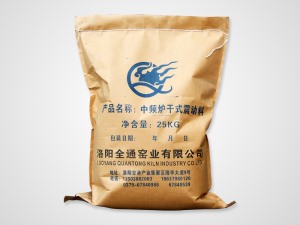About the sintering problem of intermediate frequency furnace lining materials
The quality of the intermediate frequency furnace lining material has a direct impact on the smelting efficiency. A good lining can be smelted for 600 heats. The poor lining has more than 100 heats, and even dozens of heats need to be re-knotted. Frequent knotting of the lining not only affects Production efficiency, but also waste of money on knotting the charge. The following Xiaobian will introduce the correct knotting method to us.
1. The role of the temperature sensing line
In the sintering operation, the overall temperature control is very important. In order to clearly understand the temperature in the furnace, we will connect 2-3 temperature measuring points at the bottom and the middle in advance, and carry out our sintering process according to the detected temperature.
2. The addition of batch charge to the furnace lining sintering head
In terms of the first batch of charge before the sintering process, we must give priority to the chemical composition of its material, because the main material of our quartz sand furnace lining is silicon oxide, and from the thermodynamic analysis, C and Si are at a certain temperature. A balance ratio is required. In the case of the higher the temperature of the molten iron and the higher the C content, the greater the demand for the Si content of the molten iron, because we have a holding time period of 1580-1600 degrees in the furnace lining sintering process, In the meantime, if the molten iron contains high C content and the Si content does not reach the required balance ratio, then the molten iron will accelerate the collection of silicon from the furnace lining to balance this ratio, resulting in premature erosion and thinning of the furnace lining, affecting its service life. In addition, if the C and Si contents in our first batch of furnace materials are low, the amount of iron oxide and manganese oxide will increase at a higher temperature, and these oxides will interact with the 2 of our furnace lining surface. Silica reacts to form iron silicates and manganese silicates, both of which have melting points below 1350 degrees Celsius, which also make our furnace linings thin prematurely and reduce service life.
Taking into account the above 2 points, another is to consider the density of the added furnace charge. The entire melting process of our electric furnace is that electrical energy is converted into magnetic field energy through the coil, and then the magnetic field reacts with the metal charge to convert into electrical energy, and then from electrical energy to A conversion of heat energy, since the crucible is a metal mold crucible in the furnace, if the feeding space inside the furnace is loose, the crucible part will react excessively to the magnetic field, resulting in excessive heating, and the deformation will bulge inward (the part is also related to the thickness of the crucible mold. Contact), and at this time, the quartz sand of the furnace lining is often not sintered and solidified, and the refractory material will fill the space where the mold is deformed, resulting in a decrease in the density of the furnace lining, affecting its service life.

Related News
- Introduction of construction method of ramming material in intermediate frequency furnace
- How to choose the material of furnace lining
- The difference between rammer and castable
- Application direction of intermediate frequency furnace refining
- Introduction to the construction method of dry ramming material
- Do you know the production process and control points of breathable bricks?
- The application of argon blowing technology at the bottom of the intermediate frequency furnace
- Method for prolonging service life of intermediate frequency furnace lining
- In addition to diffused breathable bricks, there are those types of breathable bricks
- What are the advantages of coil cement
- Basic introduction to coil cement
- Proper operation plan for the use of ramming mass on the bottom of an electric furnace
- Use the action of ramming material
- Talking about the performance and application of refractory ramming material
- What are the characteristics and advantages of coil cement?
- The conditions required for the selection of intermediate frequency furnace charge
- Precautions for the construction of coil cement
- What are the functional advantages of coil cement?
- 5 benefits of using dry ramming mixes
- What are the ways to extend the life of the intermediate frequency furnace lining?


